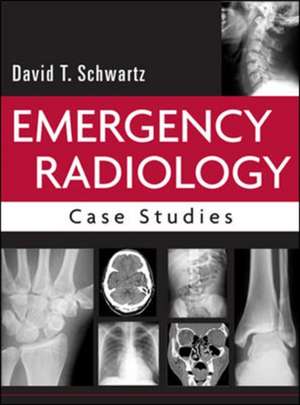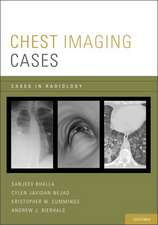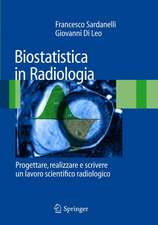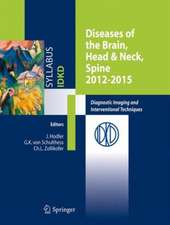Emergency Radiology: Case Studies
Autor David Schwartzen Limba Engleză Hardback – 16 noi 2007
Effectively and confidently interpret even the most challenging radiographic study
A Doody's Core Title!
"...should be a part of every emergency medicine resident's personal library. In addition to residents, I would highly recommend this book to medical students, midlevel providers and any other physician who is interested in improving their ability to interpret radiographic studies necessary to diagnose common emergency medicine patient complaints."--Annals of Emergency Medicine
4 STAR DOODY'S REVIEW!
"The purpose is to help improve the reader's skills in ordering and interpreting radiographs. The focus is on conventional radiographs, as well as noncontrast head CT. For emergency physicians this is a vital skill, which can greatly aid in making difficult diagnoses. The book is well written and thorough in addressing how to read radiographs, as well as covering easy to miss findings. The numerous pictures and radiographs are invaluable in demonstrating the author's teaching points and in engaging the reader in the clinical cases....This well written book will be extremely useful for practicing emergency physicians. The clinical cases are interesting and help challenge the reader to improve their skills at evaluating radiographs more thoroughly."--Doody's Review Service
Emergency Radiology: Case Studies is a one-of-a-kind text specifically designed to help you fine-tune your emergency radiographic interpretation and problem-solving skills. Illustrated with hundreds of high-resolution images, this reference covers the full range of clinical problems in which radiographic studies play a key role.Dr. David Schwartz, a leading educator, takes you step-by-step through the radiographic analysis of medical, surgical, and traumatic disorders, giving you an unparalleled review of the use and interpretation of radiographic studies in emergency diagnosis.
Features
- 55 cases studies that highlight challenging areas in emergency diagnosis, including imaging studies with subtle, equivocal, or potentially misleading findings
- Detailed coverage of the broad spectrum of disorders for which radiographs are utilized in emergency practice
- Coverage of chest and abdominal radiology, the extremities, cervical spine and facial radiology, and head CT
- Cohesive template for each chapter, beginning with a case presentation, followed by a comprehensive discussion of the disorder under consideration
- Sections begin with an overview of the pertinent radiographic technique, anatomy, and method of radiographic interpretation
- Diagnosis-accelerating radiographs, ultrasound images, CT scans, and MR images
- Invaluable “pearls and pitfalls” of radiographic interpretation
Preț: 1320.11 lei
Preț vechi: 1788.15 lei
-26% Nou
Puncte Express: 1980
Preț estimativ în valută:
252.64€ • 262.78$ • 208.56£
252.64€ • 262.78$ • 208.56£
Carte tipărită la comandă
Livrare economică 17-22 aprilie
Preluare comenzi: 021 569.72.76
Specificații
ISBN-13: 9780071409179
ISBN-10: 0071409173
Pagini: 592
Dimensiuni: 221 x 279 x 30 mm
Greutate: 1.85 kg
Editura: McGraw Hill Education
Colecția McGraw Hill / Medical
Locul publicării:United States
ISBN-10: 0071409173
Pagini: 592
Dimensiuni: 221 x 279 x 30 mm
Greutate: 1.85 kg
Editura: McGraw Hill Education
Colecția McGraw Hill / Medical
Locul publicării:United States
Cuprins
MAIN CONTENTS
PrefaceAcknowledgments
Contents by diagnosis
SECTION I--Chest Radiology
1. Cough and fever in an elderly man
2. Cough and fever in an young man
3. Non-productive cough, fever and myalgia in a young man
4. Shortness of breath in a young woman
5. Back pain in a middle-aged man
6. Cough and fever in a young man
7. Cough producing blood-tinged sputum in a young man with a history of alcoholism
8. Weakness and nausea in a women with a history of breast cancer
9. Chest pain of sudden onset in a young man
10. Chest pain in a young man after receiving a blow to the chest
11. A pedestrian struck by a motor vehicle
12. Abdominal pain in a middle-aged man
13. Chest pain and dyspnea in an elderly woman with COPD
14. Partial opacification of the thorax in two patients
Section II--Abdominal Radiology
1. Periumbilical and left lower quadrant abdominal pain in a middle-aged man
2. Severe respiratory distress in an elderly man
3. Abdominal pain and vomiting in a middle-aged man with history of alcoholism
4. A 2-year-old girl with intermittent abdominal pain and vomiting
5. Right upper quadrant pain in an elderly man with diabetes
6. Abdominal pain and vomiting in an elderly woman with diabetes
7. Weakness and jaundice in a middle-aged woman
8. Abdominal discomfort in a middle-aged man with renal failure
Section III--Skeletal Radiology: The Extremities--Upper Extremity
1. Elbow and forearm injuries in a young man hit with a nightstick
2. An elbow injury in a 7-year-old girl who fell onto her outstretched hand
3. Wrist pain after minor trauma in a young man
4. Six patients with wrist injuries and "negative" radiographs
5. A wrist injury in an elderly woman who fell onto her outstretched arm
6. A shoulder injury in a young man who fell onto his outstretched arm
7. A shoulder injury in an elderly woman who fell
8. Shoulder pain in an elderly woman that radiated down her arm
Section IV--Lower Extremity
1. An ankle injury in a middle-aged woman
2. An ankle sprain in a young man sustained while playing softball
3. Knee pain in two patients following minor trauma
4. Hip injuries in elderly women who fell from standing
5. Pelvic pain in a young man who fell from a scaffolding
6. Pelvic pain in a young woman following a motor vehicle collision
7. A puncture wound to the foot of a young woman
Section V--Cervical Spine Injuries
1. Neck pain in a middle-aged man struck by a slow-moving motor vehicle
2. A neck injury sustained in a high-speed motor vehicle collision
3. A neck injury sustained in a high-speed motor vehicle collision
4. A neck injury in a young man who fell off of a subway platform onto his head
5. Neck pain in a middle-aged man involved in a slow-moving motor vehicle collision
6. Neck pain in a middle-aged man who fell backwards off a ladder the day before coming to the ED
Section VI--Head CT
1. Head injury in an elderly man found on the ground outside a bar; head CT was "normal"
2. Head injury in a young man who was struck with a bat
3. How to read a head CT in a patient with head trauma
4. Occipital headache and vomiting in a middle-aged woman; head CT was "normal"
5. Persistent headache for five days in a young man
6. How to read a head CT in a patient with headache
7. Lethargy and fever in an elderly man; head CT was performed prior to LP
8. Headache, unilateral hearing loss and blurred vision in a young woman
9. Abrupt onset of hemiparesis in an elderly man
10. Left-sided weakness that began six days earlier in an elderly woman
11. Right hemiparesis that began 20 minutes before ED arrival in an elderly woman
Section VII--Facial Trauma
1. Two patient








